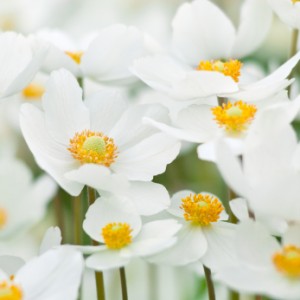Anemone
Anemone gets its name from “anemos”, the greek word for wind. It is sometimes called the windflower and the botanical name is pronounced a-NEM-o-nee.
Description
These perennial flowers have long stems and petals that flower in a variety of colours. The petals are small and round and most flower heads have about five or six petals.
Habitat
Anemones grow wild in countries as diverse as Israel, Japan and Britain, and the flowers will grow well in any loamy soil, particularly when slightly acidic and enriched with compost.
Availability
Planting in October will typically provide flowers in May and June of the following year. Anemones are grown commercially all over the world and can be grown cheaply from bulb or seed.
Species
Anemone species are members of the Ranunculaceae family. Estimations vary on the exact number of known species, but it is certainly in excess of 150, with popular varieties including Snowdrop Anemone (Anemone sylvestris), Japanese Anemone (Anemone hupehensis) and Greek anemone (Anemone blanda).
Care Tips
When growing anemones from bulbs, always soak them overnight in a small bowl of water to prepare them for growth. If growing in outdoor beds, give your anemones direct sun for anything from half to a full day, and plant in 1-2 inch holes. Anemones can also grow successfully in tubs, barrels and urns if placed in good quality soil with adequate drainage holes.
Did You Know?
- Legend has it that the Greek goddess Aphrodite’s tears gave life to anemones as she wept in mourning for the death of the god Adonis. Anemones are linked with anticipation, and are thought to close their petals as a signal that rain is coming.
- Some myths claim that magic fairies make their beds under the petals of anemones after sunset.
Resources
http://www.easytogrowbulbs.com/g-63-anemones.aspx
http://en.wikipedia.org/wiki/Anemone



